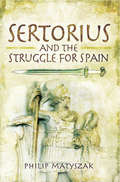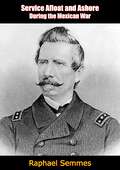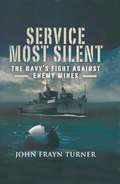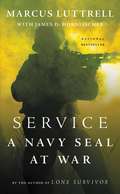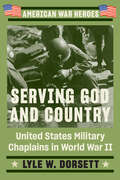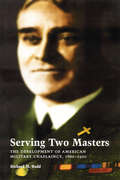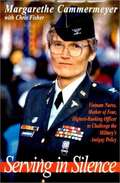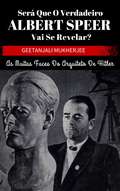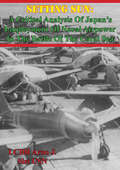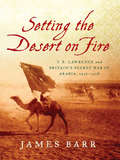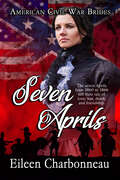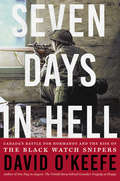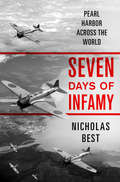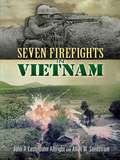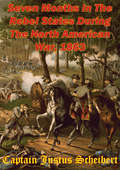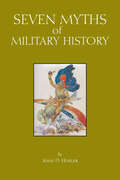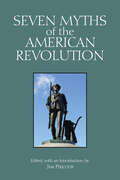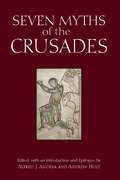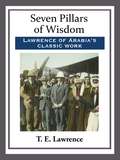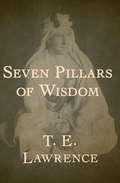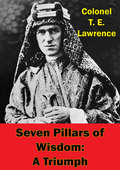- Table View
- List View
Sertorius and the Struggle for Spain
by Philip MatyszakThe epic battle to liberate Spain from Roman rule is a masterclass of ancient guerilla warfare, recounted by the author of Ancient Rome on 5 Denarii a Day. In the year 82 BC, after a brutal civil war, the dictator Sulla took power in Rome. But among those who refused to accept his rule was the young army officer Quintus Sertorius. Sertorius fled, first to Africa and then to Spain, where he made common cause with the native people who had been savagely oppressed by a succession of corrupt Roman governors. Discovering a genius for guerilla warfare—and claiming to receive divine guidance from Artemis—Sertorius came close to driving the Romans out of Spain altogether. Rome responded by sending reinforcements under the control of Gen. Gnaeus Pompeius Magnus, who would go on to become Pompey the Great. The epic struggle between these two commanders, known as the Sertorian War, is a masterclass of ancient strategy and tactical maneuver. Massively outnumbered, Sertorius remained undefeated on the battlefield, but was eventually assassinated by jealous subordinates, none of whom proved a match for Pompey. The tale of Sertorius is both the story of a people struggling to liberate themselves from oppressive rule, and the story of a man who started as an idealist and ended almost as savage and despotic as his enemies. But above all, it is the story of a duel between two great generals, fought between two different styles of army in the valleys of the Spanish interior.
Servant of the American Nation
by Charles F. BrowerAs historian and biographer Mark Stoler has observed, the extraordinary career of George C. Marshall in the first half of the twentieth century paralleled the emergence of the United States as a great power. Indeed, this great servant-leader contributed substantively to virtually every important event and issue comprising that ascendance. Bringing together a who's who of Marshall scholars, this volume examines the major roles assumed by Marshall over his five-decade career - Soldier; Statesman and Peacemaker; and Leader and Manager - to illuminate key issues and themes surrounding the man and his era.
Service Afloat and Ashore During the Mexican War
by Raphael SemmesPublished in 1851, this is the history of and personal experiences of then, Lt. Raphael Semmes, U.S.N. Semmes, during the Mexican War. Semmes would later become the Captain of the infamous Confederate ship, the C.S.S. Alabama during the Civil War.-Print ed.Contains details of the battles of Mexico, and a survey of the line of operation of the U.S. Army, under the command of major-general Winfield Scott in 1847.
Service Industries Marketing: New Approaches
by Mark Gabbott Gillian HoggThis book covers a wide spectrum of topics, service contexts and methodologies and reflects the broad range of current services research. Its aim is to provide an eclectic overview of services marketing by including papers that demonstrate the breadth and depth of research in this area, and it reflects the international scope and the strength of the discipline as we enter the new millennium.
Service Most Silent: The Navy's Fight Against Enemy Mines
by John Frayn TurnerFrom the very outset of war Nazi Germany demonstrated its determination and ability to lay siege to the British Isles by the laying of mines in shipping lanes. Losses to both merchant ships and naval vessels became a serious factor. If supplies continued to be lost by a combination of U-Boat and mine attacks the very survival of the nation was at risk. Finding counter-measures to the German mine offensive was thus a top priority. The responsibility for this vital work rested with a small group of highly skilled and courageous naval specialists based at HMS Vernon, the RN's mine and torpedo shore-base at Portsmouth. Ranged against them was a growing and ingenious array of weapons: magnetic, acoustic, oyster, booby-trap mines to name but four varieties. Some were laid by boat, others dropped from the air. The story of HMS Vernon's contribution led by men such as Commander JGD Ouvry DSO and Captain R L Lewis DSO and many other courageous figures has been written by John Frayn Turner, the distinguished historian who served with them.He adopts a fast moving style to describe the near continuous struggle to detect, understand and master the best efforts of the German war machine. He brings home the constant deadly danger faced by these highly skilled and dedicated men.
Service: A Navy SEAL at War
by Marcus Luttrell James D. HornfischerNavy SEAL Marcus Luttrell returned from his star-crossed mission in Afghanistan with his bones shattered and his heart broken. So many had given their lives to save him-and he would have readily done the same for them. As he recuperated, he wondered why he and others, from America's founding to today, had been willing to sacrifice everything-including themselves-for the sake of family, nation, and freedom.In Service, we follow Marcus Luttrell to Iraq, where he returns to the battlefield as a member of SEAL Team 5 to help take on the most dangerous city in the world: Ramadi, the capital of war-torn Al Anbar Province. There, in six months of high-intensity urban combat, he would be part of what has been called the greatest victory in the history of U.S. Special Operations forces. We also return to Afghanistan and Operation Redwing, where Luttrell offers powerful new details about his miraculous rescue. Throughout, he reflects on what it really means to take on a higher calling, about the men he's seen lose their lives for their country, and the legacy of those who came and bled before.A thrilling war story, Service is also a profoundly moving tribute to the warrior brotherhood, to the belief that nobody goes it alone, and no one will be left behind.
Serving God and Country
by Lyle W. DorsettIn World War II, more than twelve thousand Protestant ministers, Catholic priests, and Jewish rabbis joined the Chaplain Corps. They were men of faith under fire. And they would charge straight into Hell to save the soul of a single soldier... Representing America's three major religious traditions, volunteers from across the country enlisted as noncombatant commissioned officers to provide spiritual strength and guidance for those fighting men who never knew if they were going to survive. Armed only with Bibles, Torahs, and the tools of their holy trade, these men of God went wherever the troops went. They prayed over men about to go into combat on land, at sea, and in the air. And, most important and difficult of all, they guided fallen fighting men of every faith as they breathed their last, and gave up their lives in the fight against tyranny. These are the personal stories of some of the bravest and most selfless men who served with the armed forces. Many lost their lives or suffered debilitating wounds as they strived to keep the military personnel spiritually awake, morally fit--and prepared to make the journey from this world to the next without fear or despair, and with the trust of the Almighty in their hearts. INCLUDES PHOTOGRAPHS
Serving Two Masters: The Development of American Military Chaplaincy, 1860-1920
by Richard M. BuddChaplain Richard M. Budd has made a welcome, concise, well written and researched contribution to an overlooked chapter in chaplain history. Anyone interested in gaining a better understanding of how the professional and fully institutionalized chaplaincy of today's military came about would do well by consulting Budd's book." --Bradley L. Carter, On Point. Military chaplains have a long and distinguished tradition in the United States, but historians have typically ignored their vital role in ministering to the needs of soldiers and sailors. Richard M. Budd corrects this omission with a thoughtful history of the chaplains who sought to create a viable institutional structure for themselves within the U.S. Army and Navy that would best enable them to minister to the fighting men.Despite the chaplaincy's long history of accompanying American armies into battle, there has never been consensus on its role within the military, among the churches, or even among chaplains themselves. Each of these constituencies has had its own vision for chaplains, and these ideas have evolved with changing social conditions and military growth. Moreover, chaplains, acting as members of one profession operating within the specific environment of another, raised questions of whether they could or should integrate themselves into the military. In effect they had to learn to serve two institutional masters, the church and the government, simultaneously. Budd provides a history of the struggle of chaplains to professionalize their ranks and to obtain a significant measure of autonomy within the military's bureaucratic structure--always with the ultimate goal of more efficiently bringing their spiritual message to the troops.
Serving in Silence: The Story of Margarethe Cammermeyer
by Chris Fisher Margarethe CammermeyerIn 1989, in a routine interview for top-secret security clearance - a requisite for admission to the Army War College - Colonel Margarethe Cammermeyer was asked about her sexual orientation. After pausing for a moment to take a breath, she said, "I am a lesbian." Thus began an ordeal that continues to this day. Intense media coverage of the former colonel's dismissal from the U.S. Army has stirred debate all the way to the presidency. Her Bronze Star for duty in Vietnam, her being named Nurse of the Year by the Veterans Administration, and her role as Chief Nurse of the Washington State National Guard marked a long and distinguished military career. Her goal to become Chief Nurse of the entire National Guard was abruptly ended in 1992 by her discharge based on sexual orientation. With the same calm, assured articulation that won her one leadership position after another, Cammermeyer writes of her decision to challenge official policy on homosexuality and of her recent victory in Federal District Court. But this is not only a book about what she described in Time as "sticking around to get beaten up." It is also about coming of age, being a mother, and finding one's center; about "coming out," the daily horrors of nursing in Vietnam, and a female soldier's life.
Será que o verdadeiro Albert Speer vai se revelar? As muitas faces do arquiteto de Hitler
by Geetanjali MukherjeeEle apresentou muitos rostos ao mundo, mas qual deles era o genuíno? Ao longo dos anos, Albert Speer recebeu vários títulos – "o bom nazista", "arquiteto de Hitler", "futuro chanceler do Reich" e até mesmo "o único penitente em Nuremberg". Não há dúvida de que há muitas faces para Albert Speer: ele foi um homem que teve, durante a guerra, poder muito maior do que o de qualquer outro além de Hitler, e era amplamente considerado para suceder Hitler; seus fantásticos poderes de organização elevaram a produção alemã ao seu pico, num momento em que os recursos eram mínimos; e era esperado por todos, incluindo ele mesmo, que ele receberia a sentença de morte como os outros líderes nazistas, em vez escapar da forca com apenas vinte anos. À luz de seu envolvimento prolongado no partido nazista, tanto como arquiteto de Hitler quanto como ministro de armamentos, e de suas contribuições para a guerra ilegal travada pelo regime, a pergunta surge naturalmente: Speer recebeu punição adequada? Será que o veredicto reflete a percepção de que Speer era de alguma forma "menos culpado" do que os outros réus, ou ele dirigiu sua defesa de uma maneira que reduziu sua sentença? Os eventos que levaram ao julgamento de Nuremberg e ao julgamento em si fornecem pistas para responder a estas perguntas: o que podemos aprender sobre a personalidade de Speer com base nas evidências disponíveis, e por que isso importa?
Setting Priorities in the Age of Austerity: British, French, and German Experiences
by Michael ShurkinExamines the British, French, and German armies' approaches to accommodating significant budget cuts while attempting to sustain their commitment to full spectrum operations. Specifically, it looks at the choices these armies are making with respect to how they spend dwindling resources: What force structure do they identify as optimal? How much readiness do they regard as necessary? Which capabilities are they abandoning?
Setting Sun: A Critical Analysis Of Japan’s Employment Of Naval Airpower In The Battle Of The Coral Sea
by LCDR Arno J. Sist USNThe Battle of the Coral Sea, the first naval engagement fought exclusively between Naval Air forces, was a pivotal battle of the war in the Pacific. Although considered a Japanese tactical victory, it was the beginning of the end of Japan's war effort. This analysis examines this decisive battle from the Japanese perspective. The critical analysis will include a summary of the reasons why the battle unfolded as it did, and will draw conclusions as to how the Japanese may have been more successful both strategically and tactically in this key battle of World War II.
Setting the Desert on Fire: T. E. Lawrence and Britain's Secret War in Arabia, 1916-1918
by James BarrGreed and intrigue combine explosively in this gripping tale of how the mercurial Lawrence of Arabia changed the Middle East forever. It was T. E. Lawrence's classic Seven Pillars of Wisdom that made the Arab Revolt a legend and helped turn the British intelligence officer into the mythical "Lawrence of Arabia." But the intrigue behind the revolt and its startling consequences for the present-day Middle East have remained a mystery for nearly one hundred years. James Barr spent four years trawling declassified archives in Europe and crossing the hostile deserts of the Middle East to re-create the revolt as the international drama it really was. A colorful cast of Arab sheiks, British and French soldiers, spies, and diplomats come together in this gripping narrative of political maneuvering, guerrilla warfare, and imperial greed. Setting the Desert on Fire is a masterly account of a key moment in the history of the Middle East, and a portrait of Lawrence himself that is bright, nuanced, and full of fresh insights into the true nature of the master mythmaker.
Setting the East Ablaze: Lenin's Dream of an Empire in Asia
by Peter Hopkirk'Let us turn our faces towards Asia', exhorted Lenin when the long-awaited revolution in Europe failed to materialize. 'The East will help us conquer the West.' Peter Hopkirk's book tells for the first time the story of the Bolshevik attempt to set the East ablaze with the heady new gospel of Marxism. Lenin's dream was to liberate the whole of Asia, but his starting point was British India. A shadowy undeclared war followed. Among the players in this new Great Game were British spies, Communist revolutionaries, Muslim visionaries and Chinese warlords - as well as a White Russian baron who roasted his Bolshevik captives alive. Here is an extraordinary tale of intrigue and treachery, barbarism and civil war, whose violent repercussions continue to be felt in Central Asia today.
Seven Aprils: American Civil War Brides (American Civil War Brides #1)
by Eileen CharbonneauIn April 1860, Dr. Ryder Cole returns home from his studies, sure of his abilities and on fire to serve his country and preserve the Union. A panther attack threatens to cut his life short until a young woman with a rife and a sure-shot eye appears out of the mist. Then she disappears, re-turning as Tom Boyde, his comrade throughout America’s Civil War, and as Diana, met in a Washington D.C. whore house. The seven Aprils from 1860 to 1866 tell their tale of love and war, sex and friendship. And the price of crossing gender lines.
Seven Days in Hell: Canada's Battle for Normandy and the Rise of the Black Watch Snipers
by David O'KeefeCentred around one of Canada’s most storied regiments, Seven Days in Hell tells the epic story of the men from the Black Watch during the bloody battle for Verrières Ridge, a dramatic saga that unfolded just weeks after one of Canada’s greatest military triumphs of the Second World War. O’Keefe takes us on a heart-pounding journey at the sharp end of combat during the infamous Normandy campaign. More than 300 soldiers from the Black Watch found themselves pinned down, as the result of strategic blunders and the fog of war, and only a handful walked away. Thrust into a nightmare, Black Watch Highlanders who hailed from across Canada, the United States, Great Britain and the Allied world found themselves embroiled in a mortal contest against elite Waffen-SS units and grizzled Eastern Front veterans, where station, rank, race and religion mattered little, and only character won the day. Drawing on formerly classified documents and rare first-person testimony of the men who fought on the front lines, O’Keefe follows the footsteps of the ghosts of Normandy, giving a voice yet again to the men who sacrificed everything in the summer of 1944.
Seven Days of Infamy: Pearl Harbor Across the World
by Nicholas BestDecember 7, 1941: One of those rare days in world history that people remember exactly where they were, what they were doing, and how they felt when they heard the news.Marlene Dietrich, Clark Gable, and James Cagney were in Hollywood. Kurt Vonnegut was in the bath, and Dwight D. Eisenhower was napping. Kirk Douglas was a waiter in New York, getting nowhere with Lauren Bacall. Ed Murrow was preparing for a round of golf in Washington. In Seven Days of Infamy, historian Nicholas Best uses fascinating individual perspectives to relate the story of Japan's momentous attack on Pearl Harbor and its global repercussions in tense, dramatic style. But he doesn't stop there.Instead, Best takes readers on an unprecedented journey through the days surrounding the attack, providing a snapshot of figures around the world--from Ernest Hemingway on the road in Texas to Jack Kennedy playing touch football in Washington; Mao Tse-tung training his forces in Yun'an and the Jews in Nazi-occupied Europe cheering as the United States entered the war.Offering a human look at an event that would forever alter the global landscape, Seven Days of Infamy chronicles one of the most extraordinary weeks in world history.
Seven Firefights in Vietnam
by John Albright Allan W. Sandstrum John A. CashBased on official U.S. Army records, these eyewitness chronicles of seven horrific battles offer an unparalleled glimpse of the day-to-day reality of the Vietnam conflict. From a fierce fight on the banks of the Ia Drang River in November 1965 to a May '68 gunship mission, these highly charged reports convey the heroism and horror of modern warfare.Each of these compelling narratives reflects events that took place throughout Vietnam after American troops were first committed in force in 1965. In addition to the achievements and sacrifices common to any war, this struggle was further complicated by an extremely elusive enemy and a new strategic dimension afforded by the helicopter--aspects that added a high degree of error, experimentation, and innovation. These accounts analyze the performance of individual soldiers under fire, illustrating both the reality of fear and the effects of military discipline and leadership.Sources for this book include daily journals, after-action reports, and official interviews that took place immediately after the battles, along with subsequent interviews and correspondence conducted by the authors. Maps and other illustrations illuminate the text.
Seven Months In The Rebel States During The North American War, 1863
by Joseph C. Hayes Captain Justus Scheibert Wm. S Poole"Captain Scheibert's [book] was available only in German until W. S. Poole edited the present version. A member of the Prussian army since 1849, and 'well known as an authority on fortifications,' Scheibert was sent to America 'to study the effect of rifled cannon fire on earth, masonry, and iron, and the operation of armor on land and at sea.' The captain preferred to observe the South rather than the North at war. 'If there ever was a foreign Rebel,' Mr. Poole asserts, 'he was one.' Scheibert, impressed with the South's 'enormous energy' and 'amazed at the industry of a patriotic people,' was cordially received by President Davis and Generals Lee, Jackson, Beauregard, and Stuart. The vivid impressions, observations, and characterizations of a Prussian captain are a significant commentary on the engagements at Chancellorsville, Brandy Station, and Gettysburg, on blockade running, and on the spirit of the people and their military genius."--Journal of Southern History
Seven Myths of Military History (Myths of History: A Hackett Series)
by John D. Hosler&“This brief, provocative, and accessible book offers snapshots of seven pernicious myths in military history that have been perpetrated on unsuspecting students, readers, moviegoers, game players, and politicians. It promotes awareness of how myths are created by 'the spurious misuse and ignorance of history' and howmisleading ideas about a military problem, as in asymmetric warfare, can lead to misguided solutions. &“Both scholarly and engaging, this book is an ideal addition to military history and historical methodology courses. In fact, it could be fruitfully used in any course that teaches critical thinking skills, including courses outside the discipline of history. Military history has a broad appeal to students, and there&’s something here for everyone. From the so-called 'Western Way of War' to its sister-myth, technological determinism, to the &‘academic party game&’ of once-faddish &‘Military Revolutions,&’ the book shows that while myths about history may be fun, myth busting is the most fun of all.&”—Reina Pennington, Norwich University
Seven Myths of the American Revolution (Myths of History: A Hackett Series)
by Jim Piecuch&“In fast-paced, crystal-clear prose, these four veteran historians quash not just seven myths about the American Revolution but dozens. If you think that slavery was inevitable, that British commanders were lazy nincompoops, or that Indigenous warriors were nothing more than British pawns, you will savor the challenge of Seven Myths of the American Revolution just as much as I did.&” —Woody Holton, University of South Carolina, author of Liberty Is Sweet: The Hidden History of the American Revolution (Simon & Schuster, 2021)
Seven Myths of the Crusades
by Alfred J. Andrea Andrew Holt" Seven Myths of the Crusades ' rebuttal of the persistent and multifarious misconceptions associated with topics including the First Crusade, anti-Judaism and the Crusades, the crusader states, the Children's Crusade, the Templars and past and present Islamic-Christian relations proves, once and for all, that real history is far more fascinating than conspiracy theories, pseudo-history and myth-mongering. This book is a powerful witness to the dangers of the misappropriation and misinterpretation of the past and the false parallels so often drawn between the crusades and later historical events ranging from nineteenth-century colonialism to the protest movements of the 1960s to the events of 9/11. This volume's authors have venerable track records in teaching and researching the crusading movement, and anyone curious about the crusades would do well to start here. " --Jessalynn Bird, Dominican University, co-Editor of Crusade and Christendom
Seven Pillars of Wisdom
by T. E. LawrenceWhen T. E. Lawrence's 'Seven Pillars of Wisdom' first appeared in 1922 it was immediately recognized as a literary masterpiece. In writing his extraordinary account of the Arab Revolt of 1916-1918 and his own role in it, T. E. Lawrence sealed his place in history and legend as Lawrence of Arabia. Widely regarded as the last great romantic war story and described by Winston Churchill as one of "the greatest books ever written in the English language," it conveys a world of wonders, written in the same committed fashion that Lawrence applied to his duties in Syria, this is a towering achievement of both autobiography and military history, as well as a first-rate adventure story. 'Seven Pillars of Wisdom' is a must read.
Seven Pillars of Wisdom
by T. E. LawrenceThe classic account of war and adventure in the Middle East that transformed T. E. Lawrence into Lawrence of Arabia Originally intended as a study of the great cities of the Middle East, Seven Pillars of Wisdom is T. E. Lawrence’s masterful account of the Arab Revolt of 1916–18. As a liaison officer for the British Forces in North Africa, Lawrence advised local tribesmen in their rebellion against the Ottoman Turks. He fought alongside future king Emir Faisal and played a crucial role in convincing rival Arab leaders to coordinate their efforts. A fascinating blend of autobiography, military history, and adventure story, Seven Pillars of Wisdom is a towering literary achievement befitting the man known around the world as Lawrence of Arabia. This ebook has been professionally proofread to ensure accuracy and readability on all devices.
Seven Pillars of Wisdom: A Triumph. [Illustrated Edition]
by Colonel T. E. LawrenceIncludes World War One In The Desert Illustration Pack-- 115 photos/illustrations and 19 maps spanning the Desert campaigns 1914-1918SEVEN PILLARS OF WISDOM needs little introduction as a book; famous the world over, as the wartime memoirs of T.E. Lawrence or Lawrence of Arabia. Lawrence served as liaison officer with rebel forces during the Arab Revolt against the Ottoman Turks of 1916 to 1918, becoming the heartbeat and focal point of the rebellion as time went on. His highly personal narrative is as fresh and fascinating as when it was first written.Highly recommended.
